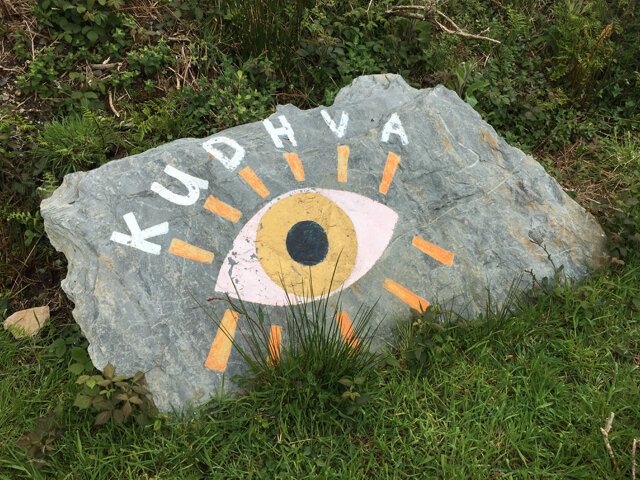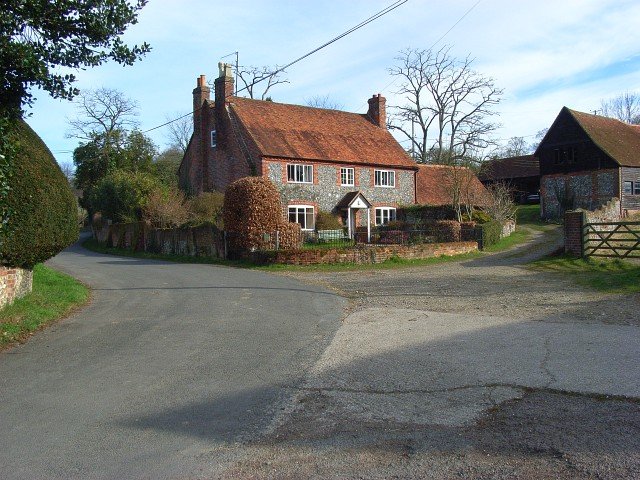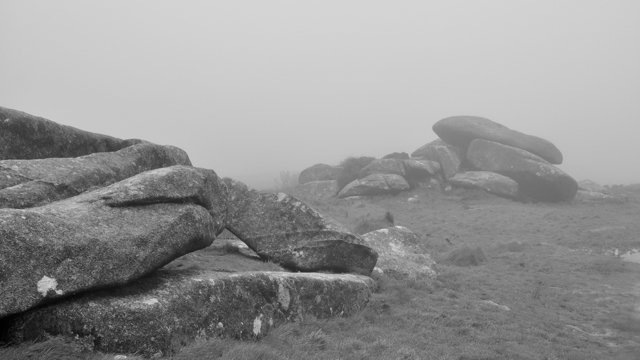A Cornish hideout
Tucked away in a disused slate quarry a few miles from Tintagel lies Kudhva, which is Cornish for hideout, an off-grid campsite consisting of cabins on stilts, tepees, a Danish Cabin and Tentsiles.
We arrived some time after 6pm to be greeted by a handsome young couple, the man posh and dapper, the woman blonde and South African. The man showed us around as if he owned the place; in fact, he was a guest like us, and had just been shown around himself by Aaron (summed up in the Daily Telegraph’s review as “barefoot and dreadlocked”; he’s actually a nice guy and an amazing self-taught carpenter), who worked there but we didn’t see until later. We ended up having dinner and Prosecco in Kudhva’s wooden shack canteen with the couple, who lived in London. We chatted pleasantly with them, obviously they asked us nothing at all about our lives but liked talking about themselves.
From the way the guy showed us around we should have guessed he was an estate agent; the woman worked in finance. They had well-paid but dull jobs and liked a taste of adventure, which is where the cult-like Kudhva comes in – the demographic presumably being London hipsters looking for an alternative hideaway. And possibly/preferably having more money than sense (I know, I officially sound like my dad, but come on, a trivet – an iron ring to place a hot dish on – is £4 from IKEA but £44 in the Kudhva shop).
The cabins themselves, variously described as insects, AT-AT walkers from Star Wars and aliens from War of the Worlds, are fascinating architecturally but awkward to move about in and pretty uncomfortable for sleep. Still, they’ve certainly got their marketing and branding right, appearing in chunky coffee table books and magazines like hole and corner, self-consciously displayed on every horizontal wooden surface.
It’s the infrastructure and logistics that need a bit of work. It was probably my fault but I ended up following a wrong path and crawling through a hedge on all fours, slipping on a wet ladder missing a rung, stinging my hand on what I thought was wild mint but was actually nettles and getting muddy walking around the flooded quarry – advertised as wild swimming, it looks about as inviting as taking a dip in the Thames Estuary.
I eventually emerged onto a stunning landscape of slate looking down to the coast. Whilst granite is noticeable in much of Cornwall, from the tors on Bodmin Moor to the rugged coastal cliffs, North Cornwall is dominated by slate, which can be seen in every wall, archway, house and, of course, roof in the area. The area’s most famous quarry, Delabole, is the oldest working quarry in the world, having been been quarrying slate for over 1,000 years, and has a mention in the Domesday Book.
Anyway, Kudahva is a unique and memorable experience. It had been a beautiful evening and the sky turned dark and stars appeared, we were in the outdoor scandinavian-style stand-up wooden hot tub over-looking the sea.
By morning it was a different story. After a brief walk around the beach at Trebarwith Strand (depressing, with holiday homes everywhere called some bollocks like Smuggler’s Cottage. Cornwall has become a victim of its own clichés. I guess at least Kudhva is trying to do something different), the rain really starting coming in. We drove around, unsure where to stop or what to do. We’d planned for breakfast at a nice cafe but it turned out to be reservation-only, despite the website saying the contrary. We drove back through the touristy Boscastle in the pouring rain, the sightseers and buildings looking grey and bleak.
The small fishing port of Boscastle is infamous for its flash flood in 2004, when almost 90mm of rain fell in an hour and some 2m tonnes of water passed through the village in 24 hours. Footage of the event shows the flooded main road looking like the River Thames and being more remininsent of an Asian tsunami than anything happening in the UK. Indeed, the Environment Agency called it “among the most extreme ever recorded in Britain.”
Amazingly, though there was much damage, no one was hurt – unlike a similar flash flood which occurred in Lynmouth, Devon in 1952 which killed thirty four people. By a bizarre coincidence, both floods happened on the same date, 16 August. A conspiracy theory has grown that the Lynmouth flood was caused by Project Cumulus, a 1950s Government initiative to artificially produce rain by planes pouring dry ice into clouds. The experiments, called cloud-seeding and operated by the RAF rainmakers, were revealed in 2001. It seems the project was shut down immediately after the 1952 Lynmouth flood.
We drove on, intending to visit a local waterfall, St Nectan’s Glen. It’s £5.95 to see the waterfall and £3 to park in their car park, which currently looked like a wet building site. We’d had enough, and, having seen signs for Pencarrow House, headed there.
Though still pouring, Pencarrow gardens were full of life – plants and flowers blooming, birds singing. Though the area around Kudhva was pretty lush, there was no birdsong and it felt dead, like all mined land does.
During the walk I noticed an old man walking his two dogs. He ignored the signs for dogs to be kept on leads – there are peacocks roaming around, and also ducklings and goslings in the lake. I saw one of his dogs jump into the lake and chase some ducks. I went up to the man and told him off, politely. He acted oblivious. Back at the ticket booth, I informed the woman working there about him. We went to the book shed, a second hand book shop near the car park. When we got back, the old man was there, lovingly brushing his dogs before putting them in the car.
I looked across the car park to the ticket booth; I made eye contact with the woman. I moved my eyes and slowly tilted my head towards the old man. She got the message and immediately started walking towards him. I told H we should get in the car and leave, fast. The woman was next to the old man in a matter of seconds.
The moment the man looked towards us, it felt like we were in a bad film: watching the woman speaking to the old man through the rainy windscreen of our car; the sound of the windscreen wipers; how the old man suddenly turns towards us, and sticks two fingers up at me; the fumbling of the gears; reversing then exiting the car park as soon as possible; the old man following directly behind us in his; losing our bearings in the rain and the panic… well, he followed us for a nail-biting ten minutes, then he turned off.



































